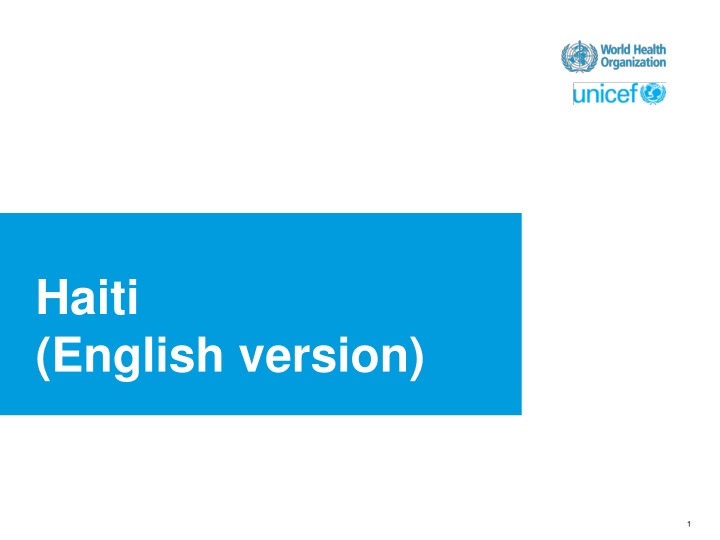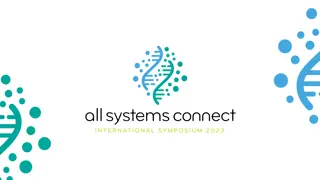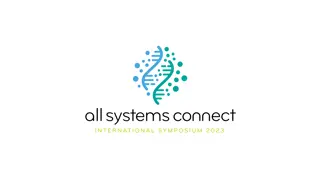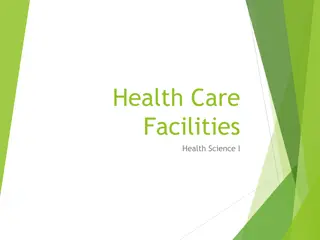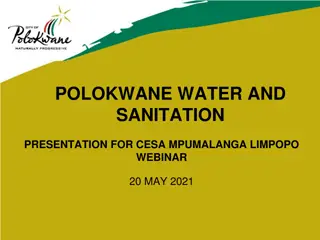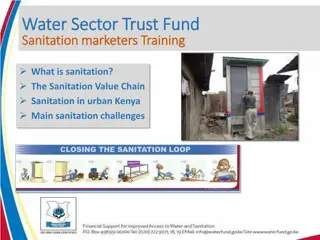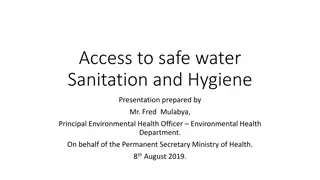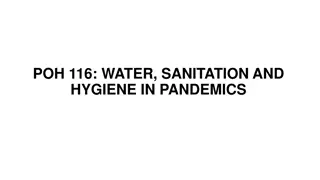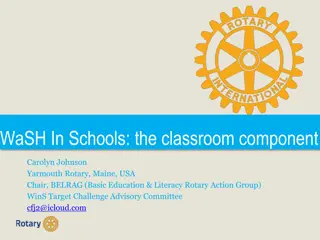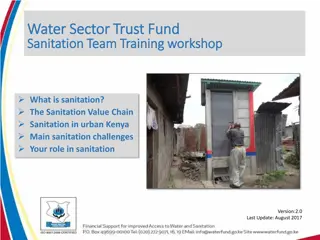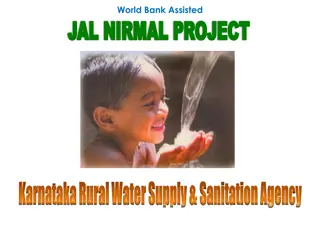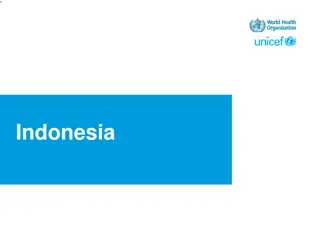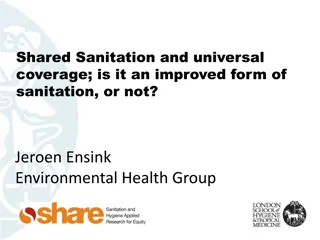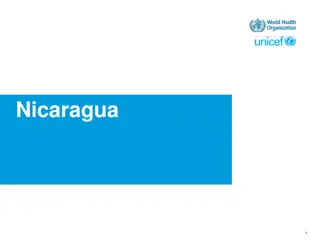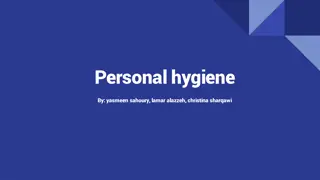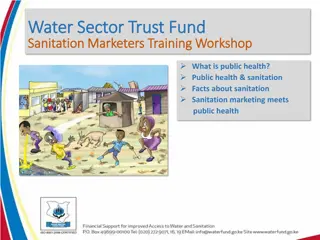Improving Water, Sanitation, and Hygiene in Haitian Health Care Facilities
Conduct comprehensive assessments to establish baselines for water, sanitation, and hygiene (WASH) in health care facilities in Haiti, identify underserved areas, develop and implement a national roadmap to improve WASH infrastructure, and establish minimum standards ensuring safe WASH practices. Despite some existing baseline data, there is a need for systematic identification of areas lacking access to essential WASH services.
Download Presentation

Please find below an Image/Link to download the presentation.
The content on the website is provided AS IS for your information and personal use only. It may not be sold, licensed, or shared on other websites without obtaining consent from the author.If you encounter any issues during the download, it is possible that the publisher has removed the file from their server.
You are allowed to download the files provided on this website for personal or commercial use, subject to the condition that they are used lawfully. All files are the property of their respective owners.
The content on the website is provided AS IS for your information and personal use only. It may not be sold, licensed, or shared on other websites without obtaining consent from the author.
E N D
Presentation Transcript
Haiti (English version) 1
1. Establish baseline What: Conduct comprehensive assessments according to the national context and, where appropriate, to quantify: the availability and quality of, and needs for safe water, sanitation and hygiene (WASH) in health care facilities; and infection prevention and control (IPC) using existing regional and global protocols or tools and in collaboration with the global effort to improve WASH in health care. Trigger questions on WASH baseline data Q1. Does your country have a baseline for WASH in HCF? If yes, share information below on the status of water, sanitation, health care waste, hygiene and cleaning. If not, share information on your plans for establishing such a baseline. Q2. Have underserved areas been identified? If yes, share information below on what/where these are are and how they are being targeted for improvement. Baseline data/plans for establishing baseline data: Haiti has a baseline conducted throught the survey Evaluation of health care service ( valuation des Prestations des Services de soins de Sant (EPSSS) , conducted in 2017-2018. Only two indicators were collected: a) HCFs with an improved water sources : Between 80-95% b) Proportion toilets per patient: between 37 to 89 according with the type of institutions Information on underserved areas: There is no systematic identification of HCFs with inadequate access to water and sanitation and they are not known by national/local instances responsible for water and sanitation. 2
2. Develop and implement roadmap What: Develop and implement a road map according to national context so that every health care facility in every setting has, commensurate with its needs: safely managed and reliable water supplies; sufficient, safely managed and accessible toilets or latrines for patients, caregivers and staff of all sexes, ages and abilities; appropriate core components of infection prevention and control (IPC) programmes, including good hand hygiene infrastructure and practices; routine, effective cleaning; safe waste management systems, including for excreta and medical waste disposal; and, whenever possible, sustainable and clean energy. Trigger questions on national roadmaps Q1. Has your country started the process of developing a national roadmap? If yes, what are the key elements included and what is the plan to finalize and implement? Q2. What specific targets are included and how do the activities map to sustainable development goals (SDG) efforts, especially those on WASH and health? Process, key elements & finalization/implementation plans of national roadmap: There is not a road map/implementation plan for WASH in HCFs. This could be developed during the joint sector revue planned for the last three months of the year. Targets and linkages to SDGs: Once developed, the roadmap will be in line with SDGs same model that the Sector Budget by Results matrix. 3
3. Establish and implement standards What: Establish and implement, according to national context, minimum standards for safe water, sanitation and hygiene (WASH) and infection prevention and control (IPC) in all health care settings and build WASH and IPC standards into accreditation and regulation systems; and establish accountability mechanisms to reinforce standards and practice. Trigger questions on standards Q1. Does your country have standards for WASH in health care facilities? Q2. What are the key elements in the standards and when were they last updated? Q3. Are there any gaps in these standards and if so, what are these gaps and how will they be addressed? Q4. How are these standards regulated, if at all? The status of national standards including gaps and plans to address: The National Water and Sanitation Directorate (DINEPA) Technical Guidance include some specifications concerning WASH in HCFs such as: norms for the construction, separation staff and patients toilets, standard about management. Some gaps: specifications by type of HCFs, access to water as a requirement to operate Regulation of standards process or plan: The MoH is responsible for the establishment of policies and regulations on WASH in HCFs. It regulates the use of service delivered by the water and sanitation operators. The DINEPA, as a national Water and Sanitation regulatory body, ensure the respect of established policies by the operators delivering the service in HCFs. a. b. 4
4. Set targets and monitor progress What: Set targets within health policies and integrate indicators for safe water, sanitation and hygiene (WASH) and infection prevention and control (IPC) into national monitoring mechanisms to establish baselines, track progress and track health system performance on a regular basis. Trigger questions on targets and monitoring Q1. What are your targets for WASH in HCF? Q2. Are high risk settings prioritized (e.g. maternity wards)? Q3. What is the process for assessing progress towards achieving these targets? Q4. How is progress incentivized? Overview of targets and prioritization: The global target is to cover 100% of HCFs with WASH services. In 2018, 25 HCFs were prioritized, based on the cholera incidence rate. For 2019-2020 a new annual planning will be established by the MoH in collaboration with DINEPA. The new targets will be presented during the annual sector review planned in November 2019. Assessing progress and use of incentives process/plan: The M&E process will be established at the same time. The experience of the pilot programme CleanHCFs in Artibonite Province will be scaled up at national level, starting by prioritized areas. 5
5. Integrate WASH into health programming What: Integrate safe water, sanitation and hygiene (WASH) into health programming, including into nutrition and maternal, child and newborn health within the context of safe, quality and integrated people-centred health services, effective universal health coverage, infection prevention and control (IPC) and antimicrobial resistance. Trigger questions on integrating WASH into health programming Q1. What are the key opportunities in specific national health programmes for WASH in health care facilities? Q2. In what ways has WASH in health care facilities been included (e.g. in training, in monitoring, etc)? Q3. What further integration needs to happen and what is the plan for doing so? Key opportunities for integration & examples: Opportunities for WASH in the health programmes: The national Director Plan for Health includes WASH in HCFs and encourages partners to include this component in their programmes. However, this integration is not systematically taken into account, or only included with monitoring or training activities, and not the service. Opportunities and plans for further integration: a. Each province must identify its needs in terms of WASH in HCFs to facilitate the national planning and prioritization by relevant instances. b. The upcoming sector review is a great opportunity to ensure a joint and efficient planning. 6
6. Allocate regular funding What: Have procedures and funding in place to operate and maintain safe water, sanitation and hygiene (WASH) and infection prevention and control (IPC) services in health facilities, and to make continuous upgrades and improvements based on needs so that infrastructure continues to operate and resources are made available to help facilities access other sources of safe water in the event of failures in the normal water supply, so that environmental and other impacts are minimized and in order to maintain hygiene practices. Trigger questions on regular funding Q1. Have capital and operation and maintenance expenditures for WASH in health care facilities been costed? Q2. Is there a budget line within Ministry of Health? Is so, what is it, and what is the gap? Q3. What plans are in place to fill in, any gaps around costs and financing? Country funding/current budget lines: There is not a specific budget line for WASH in HCFs in any of the relevant instances (MoH, DINEPA, municipalities, etc.). The discussion are ongoing with the Ministry of Finances and a mechanism has been identified for the integraytion of this line in the national budget, but the discussions have not been successful so far. Plans to address gaps: a. Create a mechanism to facilitate the identification of needs, solution, detailed budget in each province by relevant authorities (MoH, DINEPA/OREPA, municipalities). b. Develop a detailed planning to 2020-2030. c. Include WASH in HCFs in the budget of relevant instances. d. Create a funding mechanism to ensure the payment of the service. 7
7. Establish a multisectoral coordination mechanism What: Establish strong multisectoral coordination mechanisms with the active involvement of all relevant ministries, particularly those responsible for health, finance, water, and energy; to align and strengthen collaborative efforts and ensure adequate financing to support the delivery of all aspects of safe water, sanitation and hygiene (WASH) and infection prevention and control (IPC) across the health system. Trigger questions on multisectoral coordination mechanisms Q1. Is there a national multisectoral committee that coordinates, advocates and plans for efforts on WASH in health care facilities? If so, what are the key responsibilities and what has been accomplished to date? Q2. How can such a committee be strengthened? Country multisectoral coordination mechanism, responsibilities & accomplishments: National Committee for the elimination of cholera (CNLCC) Inter-sector coordination between the MoH and Ministry on Environment. This committee is in charge of providing recommendations and technical guidance for wastewater treatment in the hospitals (Mirebalais, Jacmel, Port au Prince. The WASH in HCFs coordination has to include the operational units (UADS) and infrastructure unit (DOSS) of the MoH, as well as the Technical Direction of DINEPA. - - - Process/plan for strengthening the committee: Presentation of this Committee to the highest government level for endorsement. Integration of the Ministry of Interior and Territories for the local governance of health. Fundraising for the functioning of this Committee (revision of the legal framework for WASH in HCFs, development of norms and regulations, etc.) 8
8. Develop a health workforce What: Invest in a sufficient and well-trained health workforce, including health care workers, cleaners and engineers to manage WASH services, provide ongoing maintenance and operations and perform appropriate WASH and IPC practices, including strong pre-service and ongoing in-service education and training programmes for all levels of staff; educate and raise awareness, in line with regional agreements, on water, sanitation and hygiene, with a particular focus on maternity, hospital facilities, and settings used by mothers and children Trigger questions on developing a health workforce Q1. What kind of training, mentoring and/or investments in health workforce have taken place to support the safe use and maintenance of WASH in health care facilities services? Q2. Has the WASH FIT or other similar tools been used and adapted? If so, in how many facilities and what has been the key results? Training, mentoring and/or investments in process or planned: Training/coaching of middle managers such as the provincial health engineer Regular exchanges between MoH and OREPA about WASH investments in HCFs. Use/adaptation of WASH FIT (or other tools) including numbers of facilities and key results: No experience. 9
